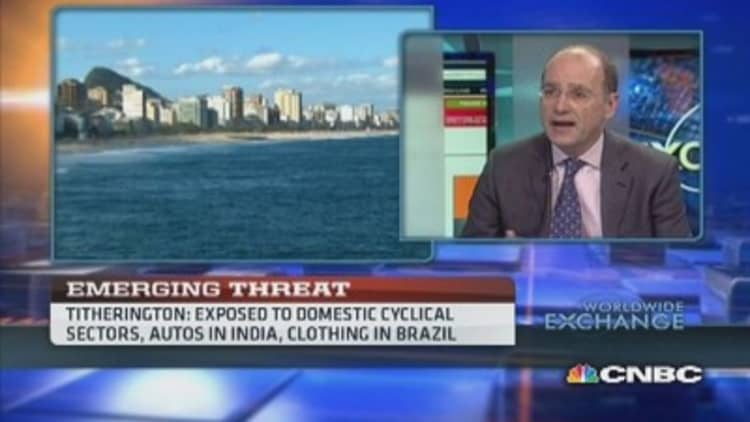A small startup, a frugal mindset and a disruptive technology are shaking up the rural banking scene in India, giving 300 million dwellers a chance to get a bank account.
India's rural economy has been growing with disposable incomes rising, especially in rural areas where spending power accounts for 57 percent of the $780 billion spent annually compared to 43 percent in urban areas.
(Read more: Are Indian shares getting ahead of themselves?)
However, 60 percent of India's rural population, compared with 40 percent overall, does not have a bank account. In spite of a robust banking infrastructure and a government aim to include the rural economy into the mainstream, only 5 percent of 600,000 villages have a commercial bank branch and just 2 percent of people living in rural India have a credit card.
The simplest and most cost-effective way to reach out to this huge untapped market is through ATMs. At present there are only 150,000 ATMs deployed in the country and are expected to reach 400,000 by 2017. But the cost of setting up bank branches or ATMs is still too high and there are still a lot of red tape and conservative attitudes in the banking business itself.
But that is set to change. At the Chennai factory of startup Vortex Engineering, technicians are building ATMs that can work far better in rural areas compared with conventional cash machines.
"This makes it a $ 500-600 million opportunity for companies like Vortex Engineering that have a customized and relevant product for the market," says Sateesh Andra, managing partner at Venture East Tenet Fund, an early investor into the company.
Vortex ATMs use only up to 100 watts – about as much as it takes to light a bulb. It can also function in temperatures up to 122 degrees Fahrenheit with no air-conditioning. It stacks notes vertically instead of horizontally so cash "fall" out of the machine rather than dispensed. Its lean design and few moving parts make it less susceptible to breakdown. And, what's more, it works on solar power.
(Read more: This major lender sees India growth at 8% in 5 years)
"Our ATM is a customized solution to rural India's unique problems where power is scarce, accessibility is poor, crisp notes are rare and the language and dialects vary. Yet, it a product that is scalable across geographies," says Kannan Lakshminarayan, co-founder and chief technology officer at Vortex Engineering – one of "top 10 startups that could change your life" according to Time magazine.
"I have always been motivated by the social impact of work on society. Local problems need local solutions. When you import solutions, you can at best be only second rate," says Lakshminarayan. So in 2005, when IIT Chennai and the State Bank of India approached him with the problems dragging down financial inclusion of the rural poor into the banking network, Kannan began building an ATM better suited for the village.
The Vortex ATM looks no different from a conventional machine. Inside, however, it was a completely new mechanism. It simplified and shortened the withdrawal and deposit process and could even take in used and soiled notes typically found in rural India. And on the top were the solar power cells that enabled it to work in remote locations.

In 2008, the first ATM rolled out of the Vortex factory as a pilot project for India's largest bank the State Bank of India. In 2009, the State Bank of India ordered 545 ATMs, of which 300 were solar. By 2011 it was selling to Nepal, Bangladesh, Djibouti and Madagascar.
"Our models are scalable, transferable and adaptable to different markets and territories," says CEO of Vortex Engineering Vijay Babu. Next year the company will roll out 5,000 ATMs to more than 20 rural bank companies and look to expand internationally.
Vortex's ATMs have pushed other established players into action. Market leader NCR, which has 50 percent of the Indian market share has begun a pilot project for solar ATMs. Meanwhile Diebold, has launched what a cash machine that can automatically switch between solar, grid or backup battery power.
However, it is still early days for startups like Vortex. "Vortex is a game-changer. Its disruptive and frugal technology is suited to the market conditions. But one still has to watch over the life cycle of an ATM and test the staying power of the OEM [Original Equipment Manufacturer] to declare the winners in the game," cautions Raghu Nathan, director of payments company Prizm, a white label ATM provider.
(Read more: What India needs to do to stamp out poverty)
What could help ATM groups like Vortex are Indian government initiatives such as only issuing new licenses to banks with at least a quarter of their business in rural areas and insisting anyone on an employment scheme must have bank account.
"We do not really have any competition. We are technology differentiators and barriers to entry in the ATMs industry are high. There are regulatory and certification requirements on software, hardware and backend connectivity. It will be a few years before anybody can replicate our technological success," Vijay Babu, CEO of Vortex Engineering says.
Till then Vortex is marching ahead with the implementation of its invention that has once again shone the light on India's tradition of frugal innovation.




